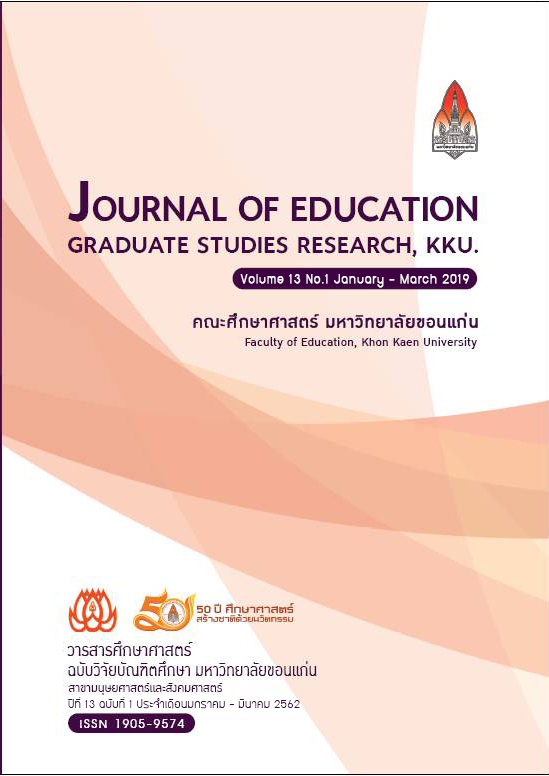Evaluation of Teachers’ Performance at the College of Social Sciences and Humanities, Mindanao State University, Main Campus Using Formal Concept Analysis
Main Article Content
บทคัดย่อ
This study was designed to evaluate teachers’ performance using Formal Concept Analysis (FCA) as the tool for evaluation and ranking. Teachers’ performance was evaluated under three key areas, namely teaching effectiveness, administrative skills, and research productivity. The questionnaire was administered to forty – five (45) faculty members (13 or 28% males and 32 or 71% females) of the College of Socials Science and Humanities (CSSH), Mindanao State University, Main Campus. The data were analyzed utilizing Formal Concept Analysis (FCA), a mathematical framework, which depicts knowledge derived from the data represented as formal context. While constructing the formal context, faculty members were considered as objects and their responses to the three key performance areas as attributes. Results of the study indicated that the lattice diagram or the graphical representation produced by Formal Concept Analysis (FCA) showed the location or rank of faculty members relative to others. In this study, those faculty members who served as teachers, hold administrative positions at present or in the past, and engaged in writing research rank highest in the graph than those faculty members who did not perform all the three key performance areas. Hence, the results concluded that Formal Concept Analysis (FCA) is a useful alternative graphical method of evaluating and ranking teachers’ performance. The findings further imply that FCA can be used to identify faculty members who deserve tenure and promotion.
Article Details
เอกสารอ้างอิง
Aswani Kumar, Ch., & Sumangali, K. (2012). Performance Evaluation of Employees of an Organization using Formal Concept Analysis. Proc. International Conference on Pattern Recognition, Informatics, and Medical Engineering (PRIME), pp 94-98. 21-23 March 2012. doi: 10.1109/ICPRIME.2012.6208293.
Heathfield, S. M. (2015). Employee Evaluation [Definition]. Retrieved from http://humanresources.about.com/od/glossarye/g/evaluation.htm
Faculty Evaluation: Policy, Criteria, and Evidence. (2015). College of Saint Benedict, Saint John’s University. Retrieved April 2, 2013, from http://www.csbsju.edu/academic-affairs/department-chairs-handbook/department-chairs-handbook/chapter-12/25-faculty-evaluation
Evaluation of Faculty Performance. (2007). Boston University Faculty Handbook. Retrieved May 2, 2013, from http://www.bu.edu/handbook/appointments-and-promotions/evaluation-of-faculty-performance/
Oregon State University Faculty. (2014). Handbook: Promotion and Tenure Guidelines. Retrieved March 15, 2013, from http://oregonstate.edu/admin/aa/faculty-handbook-promotion-and-tenure-guidelines#criteria
Belohlavek, R. (2008). Introduction to Formal Concept Analysis. Olomouc, UPOL, Faculty of Science, Department of Computer Science. Retrieved June 20, 2013, from http://phoenix.inf.upol.cz/esf/ucebni/formal.pdf
Bal, M., Bal Y., & Ustundag, A. (2011). Knowledge Representation and Discovery Using Formal Concept Analysis: An HRM Application. Proc. World Congress on Engineering, 2, 1068-1073.
Locke, E. A. (1968). Toward a Theory of Task Motivation and Incentives. Organizational Behavior and Human Performance, 3(2), 157–189. doi: 10.1016/0030-5073(68)90004-4.
Locke, E. A., & Latham, G. P. (2002). Building a Practically Useful Theory of Goal Setting and Task Motivation: A 35-year Odyssey. American Psychologist, 57(9), 705–717. doi:10.1037/0003-066X.57.9.705.
Aguinis, H. (2009). Performance Management. 2ed. New Delhi: Dorling Kindersley India Pvt. Ltd.
Mabey, C., Salaman, G., & Storey, J. (1999). Human Resource Management: A Strategic Introduction. 2nd Ed. Oxford: Blackwell Publishers.
Salaman, G., Storey, J., & Billsberry, J. (2005). Strategic Human Resource Management: Theory and Practice 2ed. London: Sage Publications.
Lunenburg, F. C. (2011). Goal-Setting Theory of Motivation. International Journal of Management, Business, and Administration, 15(1), 1-6. Retrieved January 7, 2013, from http://www.nationalforum.com/Electronic%20Journal%20Volumes/Lunenburg,%20Fred%20C.%20Goal-Setting%20Theoryof%20Motivation%20IJMBA%20V15%20N1%202011.pdf
Lunenburg, F. C. (2011). Expectancy Theory of Motivation: Motivating by Altering Expectations. International Journal of Management, Business, and Administration, 15(1).
Grant, A. M. (September 2012). "An integrated model of goal-focused coaching: an evidence-based framework for teaching and practice". International Coaching Psychology Review, 7(2), 146–165.
Gabriel, B. (n.d.). Definition of Administration Skills. Retrieved May 2, 2013, from http://www.ehow.com/info_10004211_definition-administration-skills.html
Dictionary. (2015). Faculty. Retrieved May 2, 2013, from http://dictionary.reference.com/browse/faculty
. (2015). Teaching. Retrieved May 2, 2013, from http://www.merriam-webster.com/dictionary/teaching
Thompson, D. ed. (1996). The Oxford Modern English Dictionary. 2ed. New York: Oxford University Press.
Wharton County Junior College Faculty Evaluation System. (2012). Retrieved May 2, 2013, from http://www.wcjc.edu/About-Us/administration/offices/human-resourses/documents/Appendix-I-Faculty-Evaluation-System-General-Information.pdf
Key Result Area vs Key Performance Area. [Definition]. Retrieved June 15, 2013, from http://hrdictionaryblog.com/2012/12/06/key-result-areakra-and-key-performance-areakpa/comment-page-1/

